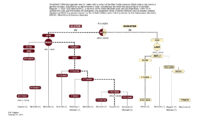Have you ever wondered about the origins of your family name and how it connects you to your ancestors? The fascinating world of genetic genealogy holds the key to unraveling these mysteries, and the story of the Megraw surname is no exception.
The practice of Anglicization, influenced by England’s historical presence in Ireland, led to modifications of Gaelic names to fit English linguistic conventions. One such name is “Megraw” and its variations, like McGraw and McGrath. These names trace their roots back to the Old Irish personal name Macraith, eventually evolving into the surname Mac Craith.
What makes Irish-Gaelic surnames intriguing is their potential to link us to specific clans, which are groups of people sharing a common surname and ancestral origins in the same area. However, the surname “Mac Craith”, because it originated as a first name, appeared independently in various parts of Ireland and at different times.
Consequently, unrelated families in different regions ended up using the same derived surnames, such as Megraw, McGraw, and McGrath.
Now, let’s explore how I used genetic tools to connect my Megraw family with another lineage sharing the same surname.
First Signs of a Family Connection
My patrilineal ancestors have resided in the townland of Magherascouse, County Down, since at least 1710. While researching, I stumbled upon the name Annesley Megraw (1876-1962), son of Arthur J. Megraw (c.1839-1922), from Ballymena, Co. Antrim. I knew nothing about this family, but the recurring occurrence of “Annesley” in every generation of my paternal line caught my attention. It sparked a hunch that a family connection might exist with my Megraws in Magherascouse, even though no evidence from paper records supported it.
In 2015, I decided to take a simple Y-67 DNA test at FamilyTreeDNA (FTDNA), despite my initial skepticism about its scientific validity. A year later, I discovered a genetic match with a direct male descendant of the mysterious Arthur J. Megraw from Ballymena. This provided further evidence of a family connection, although no concrete proof from paper records.
Four years later, I upgraded to a more advanced Y-DNA test called Big Y-700. Surprisingly, I found very few genetic matches. It became apparent that my DNA profile, like my surname, was quite rare. With hopes of finding a genetically related individual, I patiently waited for someone else to test their Y-DNA.
In the meantime, I took the popular autosomal DNA test, which examines both paternal and maternal lines to provide a broader view of our genetic ancestry. Among over 500 matches, only one stood out as relevant to my paternal ancestry: another male direct descendant of Arthur J. Megraw from Ballymena. This convinced me that the Megraws of Ballymena, County Antrim, were indeed related to my Megraws in County. Down. It also made me realize that waiting passively for answers wouldn’t suffice—I needed to take a more proactive approach.
Insights Provided by Big Y-700
In 2022, I found a male descendant in the patrilineal line of the Ballymena Megraws to take an advanced Y-DNA test. Simultaneously, I tested my son and a fourth cousin. I also recruited and analyzed the results of other testers with variants of the “Mac Craith” surname. This collaborative effort led to a genetic chart (Figure 1), similar to a descendant tree in traditional genealogy, where ancestors are represented by specific mutations known as SNPs (single nucleotide polymorphisms). Our “Megraw” results formed Group IV(a), displayed in dark purple.
One significant discovery emerged—the spelling of Mac Craith surname variants (Megraw, McGraw, McGrath, etc.) is irrelevant to genetic family connections. Furthermore, there is a clear genetic distinction between Mac Craith families in Northern (Ulster) and Southern (Munster) Ireland surfaced, as depicted in Figure 2.
Group Time Tree: Unveiling Connections
In early 2023, FTDNA introduced the Group Time Tree, a powerful visual tool to depict genetic relationships among Big Y-testers. Let’s examine our “Megraw” results in Figure 3.
Just as there is a genetic distinction between Mac Craiths in the north and south of Ireland, there is also a clear separation between families within Ulster. The yellow-coded testers are associated with Mac Craith na Uladh (“Mac Grath of Ulster”), an officially recognized sept registered with the Clans of Ireland. The lime green-coded testers, including the two Megraw families from counties Down and Antrim, belong to the Cenel Eoghain (“Kindred of Owen”) branch. These two groups diverged over 2000 years ago.
Mac Graths of Termonmagrath
The first group (Mac Craith na Uladh) is linked to the McGraths, occupying ecclesiastical lands known as Termon Magrath (Tearmann Mhic Craith) near the borders of counties Donegal, Fermanagh, and Tyrone (see map). Miler Magrath (ca. 1522-1622), an Irish priest and archbishop, was the most renowned member of this sept.
Megraws of Tir Eoghain
The second group (Cenel Eoghain), which includes my own Megraw family from Magherascouse, Co. Down, and the lineage of Arthur J. Megraw from Ballymena, Co. Antrim, constitutes a branch of the Northern Ui Néill. We are descendants of Eógan mac Néill (died ca. 465 CE), son of Niall Noigiallach (Niall of the Nine Hostages). Our ancestors hailed from the over-kingdom known as Tir Eoghain or the “Land of Owen,” giving rise to the present-day County Tyrone.
Approximately 1000 years ago, just before surnames became common in Ireland, our Ulster ancestors embarked on separate paths from another family that eventually adopted the name McGrath. Evidence suggests that the ancestors of the three testers within this lineage once resided in Co. Tyrone, specifically around Newtownstewart, before migrating to the Americas in the early 18th century.
The family line that embraced the surname Megraw remained in Ireland and settled further east in the counties of Antrim and Down. Based on our current knowledge, we estimate that a common male ancestor, identified by FTDNA as “R-BY170517,” was born between 1700 and 1750 CE. Unfortunately, historical records in Ireland do not provide information about this individual. For now, we can only identify him by his genetic code name.
Unraveling the Tapestry of Megraw Genealogy
The story of the Megraw surname is a testament to the power of genetic genealogy in uncovering family connections. By combining traditional research with cutting-edge DNA analysis, I was able to shed light on my ancestral origins, kinship groups, and migrations throughout history.
Whether your own family name holds similar secrets waiting to be unraveled or you simply find these tales of genetic exploration intriguing, the world of genetic genealogy offers endless opportunities for discovery and connection. Embrace the journey, and you may be surprised by the stories your DNA has to tell.
If you would like to learn more, please contact us.





